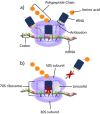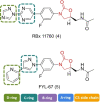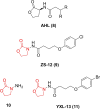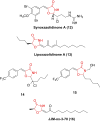Strategies to Improve the Potency of Oxazolidinones towards Bacterial Biofilms
- PMID: 35352479
- PMCID: PMC9321984
- DOI: 10.1002/asia.202200201
Strategies to Improve the Potency of Oxazolidinones towards Bacterial Biofilms
Abstract
Biofilms are part of the natural lifecycle of bacteria and are known to cause chronic infections that are difficult to treat. Most antibiotics are developed and tested against bacteria in the planktonic state and are ineffective against bacterial biofilms. The oxazolidinones, including the last resort drug linezolid, are one of the main classes of synthetic antibiotics progressed to clinical use in the last 50 years. They have a unique mechanism of action and only develop low levels of resistance in the clinical setting. With the aim of providing insight into strategies to design more potent antibiotic compounds with activity against bacterial biofilms, we review the biofilm activity of clinically approved oxazolidinones and report on structural modifications to oxazolidinones and their delivery systems which lead to enhanced anti-biofilm activity.
Keywords: Antibiotics; Biofilm; Drug Design; Drug delivery; Oxazolidinone.
© 2022 The Authors. Chemistry - An Asian Journal published by Wiley-VCH GmbH.
Conflict of interest statement
The authors declare that they have no known competing financial interests or personal relationships that could have appeared to influence the work reported in this paper.
Figures











Similar articles
-
Simple and Efficient Synthesis of 3-Aryl-2-oxazolidinone Scaffolds Enabling Increased Potency toward Biofilms.Mol Pharm. 2023 Jul 3;20(7):3484-3493. doi: 10.1021/acs.molpharmaceut.3c00095. Epub 2023 Jun 8. Mol Pharm. 2023. PMID: 37289102
-
5-Benzylidene-4-Oxazolidinones Are Synergistic with Antibiotics for the Treatment of Staphylococcus aureus Biofilms.Chembiochem. 2020 Apr 1;21(7):933-937. doi: 10.1002/cbic.201900633. Epub 2019 Dec 30. Chembiochem. 2020. PMID: 31688982 Free PMC article.
-
Current Landscape and Future Perspective of Oxazolidinone Scaffolds Containing Antibacterial Drugs.J Med Chem. 2021 Aug 12;64(15):10557-10580. doi: 10.1021/acs.jmedchem.1c00480. Epub 2021 Jul 14. J Med Chem. 2021. PMID: 34260235 Review.
-
Strategies for the Discovery of Oxazolidinone Antibacterial Agents: Development and Future Perspectives.J Med Chem. 2023 Oct 26;66(20):13860-13873. doi: 10.1021/acs.jmedchem.3c01040. Epub 2023 Oct 9. J Med Chem. 2023. PMID: 37807849 Review.
-
Leveraging Marine Natural Products as a Platform to Tackle Bacterial Resistance and Persistence.Acc Chem Res. 2021 Apr 20;54(8):1866-1877. doi: 10.1021/acs.accounts.1c00007. Epub 2021 Mar 18. Acc Chem Res. 2021. PMID: 33733746 Free PMC article.
Cited by
-
Advances in computational frameworks in the fight against TB: The way forward.Front Pharmacol. 2023 Apr 3;14:1152915. doi: 10.3389/fphar.2023.1152915. eCollection 2023. Front Pharmacol. 2023. PMID: 37077815 Free PMC article. Review.
-
Oxazolidinones as versatile scaffolds in medicinal chemistry.RSC Med Chem. 2023 Feb 8;14(5):823-847. doi: 10.1039/d2md00415a. eCollection 2023 May 25. RSC Med Chem. 2023. PMID: 37252095 Free PMC article. Review.
-
Revolutionizing tuberculosis treatment: Breakthroughs, challenges, and hope on the horizon.Acta Pharm Sin B. 2025 Mar;15(3):1311-1332. doi: 10.1016/j.apsb.2025.01.023. Epub 2025 Jan 31. Acta Pharm Sin B. 2025. PMID: 40370552 Free PMC article. Review.
-
In Vitro Activities of Oxazolidinone Antibiotics Alone and in Combination with C-TEMPO against Methicillin-Resistant Staphylococcus aureus Biofilms.Antibiotics (Basel). 2023 Dec 7;12(12):1706. doi: 10.3390/antibiotics12121706. Antibiotics (Basel). 2023. PMID: 38136740 Free PMC article.
References
-
- Martens E., Demain A. L., J. Antibiot. 2017, 70, 520–526. - PubMed
-
- Costerton J. W., Stewart Philip S., Greenberg E. P., Science 1999, 284, 1318–1322. - PubMed
-
- Wolcott R. D., Rhoads D. D., Bennett M. E., Wolcott B. M., Gogokhia L., Costerton J. W., Dowd S. E., J. Wound Care 2010, 19, 45–53. - PubMed
-
- Römling U., Balsalobre C., J. Intern. Med. 2012, 272, 541–561. - PubMed
Publication types
MeSH terms
Substances
Grants and funding
LinkOut - more resources
Full Text Sources
Molecular Biology Databases

